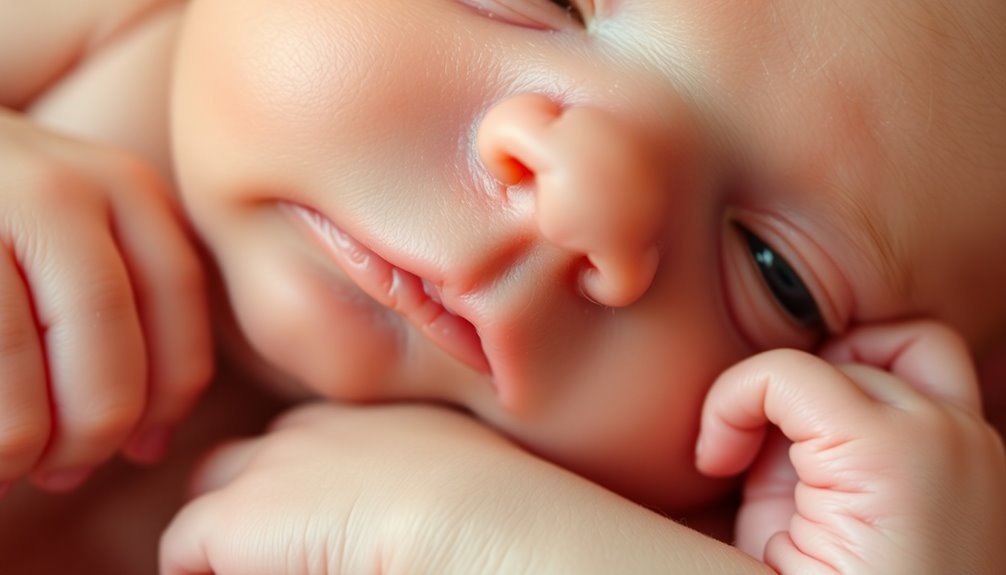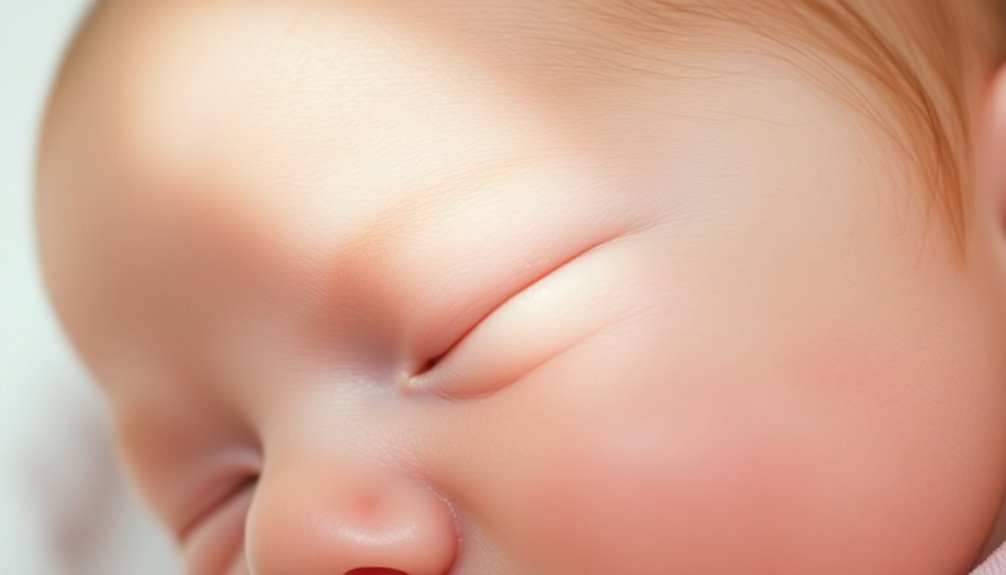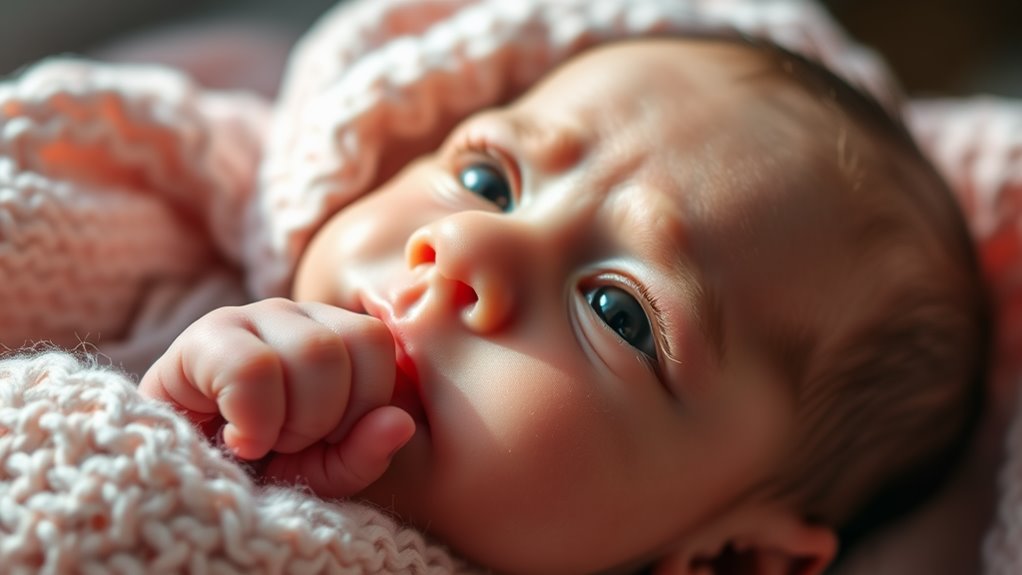Newborns have some surprising characteristics! They often have a cone-shaped head from the flexible skull bones molding during birth. Their skin may look mottled and be covered with lanugo and vernix. You'll notice reflexes like sucking and grasping, which are essential for bonding and feeding. Common skin conditions include harmless birthmarks and milia. Plus, their bowel movements can be quite frequent and varied. Curious about more fascinating facts? There's plenty more to discover!
Key Takeaways
- Newborns often have a cone-shaped head due to flexible skull bones molding during birth, allowing for easier passage through the birth canal.
- Their skin may appear mottled and is frequently covered in vernix and lanugo, which are natural protective substances.
- Newborns exhibit various reflexes, such as the sucking and grasp reflexes, indicating their needs and promoting bonding with caregivers.
- Common skin conditions include erythema toxicum and milia, which are harmless and typically resolve on their own within weeks.
- Regular check-ups are crucial to monitor growth, development, and to ensure vaccinations are administered on schedule for health protection.
Unique Physical Features of Newborns

When you first meet a newborn, you might notice their unique physical features that set them apart from older infants and children.
Newborns often have a cone-shaped head due to their flexible skull bones molding during birth, which usually rounds out within days. Their skin may appear mottled and can be covered in vernix, a protective substance, and lanugo, fine hair that typically sheds in weeks.
You might also spot soft spots on their heads, called fontanels, which allow for skull growth and close by age two. Swollen eyelids are common right after birth, and their eye color can change within the first six months.
Additionally, birthmarks like stork bites or Mongolian spots may be present but are usually harmless. Understanding the unique emotional needs of newborns can also help caregivers provide better support during their early development.
Understanding Newborn Reflexes and Behaviors

Newborns not only have unique physical features but also display a range of reflexes and behaviors that reflect their early development. These reflexes are essential for their survival and indicate how their nervous system is maturing.
| Reflex Behavior | Description | Significance |
|---|---|---|
| Sucking Reflex | Automatically sucks on objects | Aids feeding and nutrition |
| Moro Reflex | Arms flail in response to startles | Protective mechanism |
| Grasp Reflex | Fingers close tightly when pressure | Promotes bonding and security |
While newborns spend most of their time sleeping, they may show irregular breathing patterns. Understanding these reflexes and behaviors gives you insight into your newborn's development and needs. Additionally, just as newborns rely on essential reflexes, dogs also depend on instinctual behaviors for survival and communication.
Common Skin Conditions in Newborns

The delicate skin of newborns is prone to various common conditions that can be surprising for new parents. One such condition is erythema toxicum, which presents as red blotches and white bumps, but don't worry—it's harmless and usually clears up within 12 weeks.
You might also notice milia, small, harmless white bumps on your baby's face that typically disappear within weeks. Dry, peeling skin is normal in the first few days after birth, so don't overdo the lotion.
Lanugo, a fine downy hair, is often seen in premature infants and fades quickly. Finally, birthmarks like stork bites and Mongolian spots are common, generally fading or disappearing within the first 18 months. Routine health checks are important to monitor any unusual changes in your newborn's skin conditions.
They're all a normal part of your newborn's skin journey!
Feeding Patterns and Bowel Movements

As you navigate the early days with your newborn, understanding their feeding patterns and bowel movements can ease your concerns.
Breastfed newborns typically have mustard yellow stool with a cottage cheese consistency and may stool at least four times a day during the first two weeks. It's normal for them to exhibit some straining during bowel movements, even with soft stools.
Don't worry if your little one occasionally spits up; it's a common behavior unless it's accompanied by other concerning symptoms.
Remember, variation in feeding patterns and bowel movements is expected, so keep an eye out for unusual changes rather than sticking to rigid schedules. Newborn feeding options can also play a significant role in their digestive health.
Trust your instincts as you learn about your baby's unique needs.
The Importance of Newborn Check-ups

While you may be focused on adjusting to life with your new baby, don't underestimate the importance of regular check-ups. These appointments, typically scheduled within the first week after birth and throughout the first year, are essential for monitoring your newborn's growth and development.
Healthcare providers assess key signs, weight gain, and developmental milestones, allowing you to address any concerns early on. Regular check-ups guarantee vaccinations are administered on schedule, protecting your newborn from preventable diseases.
Pediatricians also evaluate feeding patterns and nutrition, making sure your baby receives adequate nourishment. As parents, you're encouraged to voice any questions or concerns about your newborn's health, fostering open communication with your healthcare provider and ensuring your baby thrives. Additionally, establishing sleep routines during these check-ups can help address common sleep challenges faced by new parents.
Frequently Asked Questions
What Are the Characteristics of a Newborn?
When you look at a newborn, you'll notice they've soft spots on their heads, allowing for growth and development.
Their skin might show harmless conditions like erythema toxicum or milia.
Puffy eyelids and a cross-eyed appearance are common but improve quickly.
The bones in their skull aren't fused, which helps shape their head during birth.
Plus, you might see vernix and lanugo, both of which are natural and protective.
What Is Abnormal Newborn Behavior?
Abnormal newborn behavior includes persistent lethargy, excessive crying, and feeding difficulties.
If your baby seems unresponsive or excessively fussy, it's essential to seek help.
Watch for abnormal feeding patterns, like refusal to latch, as these can indicate health issues.
Additionally, if you notice a lack of normal reflexes or changes in skin color, like jaundice, don't hesitate to consult a pediatrician.
Early intervention can make a significant difference in your baby's health.
What Is a Characteristic of the Average Newborn?
A characteristic of the average newborn is their sleep pattern.
You'll notice that they sleep around 16 to 18 hours a day, waking every 2 to 4 hours to feed. This frequent waking is essential for their growth and development.
Additionally, their heads might look a bit cone-shaped at first due to the birth process, and they're covered in a fine hair called lanugo, which helps keep them warm.
What Is a Condition Where a Baby Is Born With Characteristics?
When you think about newborns, you might picture soft, delicate features.
One common condition you'll notice is erythema toxicum, where red blotches and white lumps appear on a baby's skin. It's harmless and usually clears up within 12 weeks.
You may also see puffy eyelids or temporary cross-eyed looks, which often resolve on their own.
These characteristics are just part of the fascinating journey of your little one's early development.
Conclusion
As you cradle your little miracle, remember that each tiny feature and instinctual reflex is a thread in the beautiful tapestry of new life. Embrace the quirks of their soft skin and delicate feeding patterns; they're like whispers of a world yet to be explored. Regular check-ups are your compass, guiding you through this wondrous journey. So, cherish these fleeting moments, for they're the stars that light up the vast sky of parenthood.









